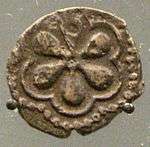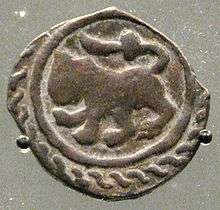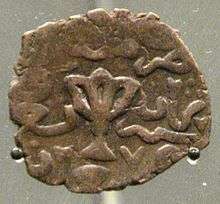List of Mamluk sultans
The following is a list of Mamluk sultans. The Mamluk Sultanate was founded in 1250 by mamluks of the Ayyubid sultan as-Salih Ayyub and it succeeded the Ayyubid state. It was based in Cairo and for much of its history, the territory of the sultanate spanned Egypt, Syria and parts of Anatolia, Upper Mesopotamia and the Hejaz. The sultanate ended with the advent of the Ottoman Empire in 1517.
There were a total of 47 sultans, although Sultan an-Nasir Muhammad reigned three times, and sultans an-Nasir Hasan, Salah ad-Din Hajji, Barquq and an-Nasir Faraj each reigned twice. The Mamluk period is generally divided into two periods, the Bahri and Burji periods. The Bahri sultans were predominantly of Turkic origins, while the Burji sultans were predominantly ethnic Circassians. While the first three Mamluk sultans, Aybak, his son al-Mansur Ali, and Qutuz, are generally considered part of the Bahri dynasty, they were not part of the Bahriyya mamluk regiment and opposed the political interests of the Bahriyya.[1] The first sultan to come from the Bahriyya's ranks was Baybars.[1] The Burji mamluks usurped the throne in 1382 with the accession of Sultan Barquq. The 34th sultan, al-Musta'in Billah, was also the Abbasid caliph and was installed in power by the Burji emirs as a figurehead.[2]
List of sultans
|
Salihi Mamluks Bahri dynasty Burji dynasty | ||||||||||
|---|---|---|---|---|---|---|---|---|---|---|
| Number | Royal title | Name | Reign start | Reign end | Ethnicity | Background notes | Coinage | |||
| 1st | Al-Malik al-Mu'izz | Izz ad-Din Aybak | 31 July 1250[3] | 10 April 1257[4] | Kipchak | Middle-ranking mamluk of Ayyubid sultan as-Salih Ayyub. Married the latter's widow, Shajar ad-Durr, who became sultan on 2 May 1250 until she abdicated in favor of Aybak.[3] | ||||
| 2nd | Al-Malik al-Mansur | Nur ad-Din Ali | 15 April 1257[5] | November 1259[5] | Kipchak | Son of Aybak. | ||||
| 3rd | Al-Malik al-Muzaffar | Sayf ad-Din Qutuz | November 1259[5] | 24 October 1260[5] | Khwarazmian[6] | A mamluk of Aybak and head of Aybak's mamluk faction, the Mu'izziya,[7] Aybak's chief deputy, and strongman of Ali's sultanate.[8] | ||||
| 4th | Al-Malik az-Zahir | Rukn ad-Din Baybars | 24 October 1260[5] | 1 July 1277[5] | Kipchak (Burch-oghlu)[9] | Bahri mamluk and founder of the Bahri dynasty.[7] | ||||
| 5th | Al-Malik as-Sa'id | Nasir ad-Din Barakah | 3 July 1277[5] | August 1279[5] | Kipchak | Son of Baybars and his wife, who was the daughter of Husam ad-Din Baraka Khan, a Khwarazmian warrior chief, after whom Barakah was named.[10][6][11] | ||||
| 6th | Al-Malik al-Adil | Badr ad-Din Salamish | August 1279[5] | November 1279[5] | Kipchak | Son of Baybars. | ||||
| 7th | Al-Malik al-Mansur | Sayf ad-Din Qalawun | November 1279[5] | 10 November 1290[5] | Kipchak (Burch-oghlu) [9] | Bahri mamluk and Baybars' chief deputy | ||||
| 8th | Al-Malik al-Ashraf | Salah ad-Din Khalil | 12 November 1290[5] | 12 December 1293[5] | Kipchak | Son of Qalawun. |  | |||
| 9th | Al-Malik an-Nasir | Nasir ad-Din Muhammad | 14 December 1293[5] | December 1294[5] | Kipchak | Son of Qalawun. First reign. | ||||
| 10th | Al-Malik al-Adil | Zayn ad-Din Kitbugha | December 1294[5] | 7 December 1296[5] | Mongol[12] | A mamluk of Qalawun.[12] |  | |||
| 11th | Al-Malik al-Mansur | Husam ad-Din Lajin | 7 December 1296[5] | 16 January 1299[5] | Greek,[12] Prussian,[12] or Circassian[13] | A mamluk of Qalawun.[12] Relative to Rukn ad-Din Baybars al-Jashnakir[13] | ||||
| 12th | Al-Malik an-Nasir | Nasir ad-Din Muhammad | 16 January 1299[5] | March 1309[5] | Kipchak | Second reign. | ||||
| 13th | Al-Malik al-Muzaffar | Rukn ad-Din Baybars al-Jashnakir | April 1309[5] | 5 March 1310[5] | Circassian[13] | A mamluk of Qalawun.[14] Relative to Husam ad-Din Lajin[13] | ||||
| 14th | Al-Malik an-Nasir | Nasir ad-Din Muhammad | 5 March 1310[5] | 6 June 1341[5] | Kipchak | Third reign. |  | |||
| 15th | Al-Malik al-Mansur | Sayf ad-Din Abu Bakr | 8 June 1341[5] | August 1341[15] | Kipchak | Son of an-Nasir Muhammad and his concubine Narjis.[16] Real power in Abu Bakr's sultanate was held by Qawsun, a mamluk and senior emir of an-Nasir Muhammad.[15] | ||||
| 16th | Al-Malik al-Ashraf | Ala'a ad-Din Kujuk | August 1341[17] | 21 January 1342[18] | Kipchak and Tatar | Son of an-Nasir Muhammad and his Tatar concubine Ardu.[16] An infant when he was made sultan by strongman Qawsun.[15] | ||||
| 17th | Al-Malik an-Nasir | Shihab ad-Din Ahmad | 21 January 1342[18] | 27 June 1342[19] | Kipchak | Son of an-Nasir Muhammad and his concubine Bayad, a freed slave girl.[16] | ||||
| 18th | Al-Malik as-Salih | Imad ad-Din Abu'l Fida Isma'il | 27 June 1342[18] | 3 August 1345[2] | Kipchak | Son of an-Nasir Muhammad and one of his concubines, unnamed by the sources.[16] | ||||
| 19th | Al-Malik al-Kamil | Sayf ad-Din Sha'ban | 3 August 1345[2] | 18 September 1346[2] | Kipchak | Son of an-Nasir Muhammad and one of his concubines, unnamed by the sources (same mother of as-Salih Isma'il).[16] | ||||
| 20th | Al-Malik al-Muzaffar | Sayf ad-Din Hajji | 18 September 1346[2] | 10 December 1347[2] | Kipchak | Son of an-Nasir Muhammad and one of his other unnamed concubines.[16] | ||||
| 21st | Al-Malik an-Nasir | Badr ad-Din Hasan | December 1347 | 21 August 1351[2] | Kipchak | Son of an-Nasir Muhammad and his concubine Kuda, who died in Hasan's infancy. First reign. Hasan acceded to the sultanate as a young child and real power was shared by four senior emirs, Shaykhu an-Nasiri, Taz an-Nasiri, Manjak al-Yusufi and Baybugha al-Qasimi. Hasan was toppled when he challenged their power. | ||||
| 22nd | Al-Malik as-Salih | Salah ad-Din Salih | 21 August 1351[2] | 20 October 1354[2] | Kipchak | Son of an-Nasir Muhammad and his wife Qutlumalik, daughter of Emir Tankiz al-Husami.[16] | ||||
| 23rd | Al-Malik an-Nasir | Badr ad-Din Hasan | 20 October 1354[2] | 16 March 1361[2] | Kipchak | Second reign. He was killed by Emir Yalbugha al-Umari.[2] | ||||
| 24th | Al-Malik al-Mansur | Salah ad-Din Muhammad | 17 March 1361[2] | 29 May 1363[2] | Kipchak | Son of Hajji. Real power was held by Emir Yalbugha al-Umari, who toppled him.[2] | ||||
| 25th | Al-Malik al-Ashraf | Zayn ad-Din Sha'ban (Sha'ban II) | 29 May 1363[2] | 15 March 1377[2] | Kipchak | Son of al-Amjad Husayn (d. 21 January 1363), the last surviving son of an-Nasir Muhammad who never reigned,[20] and Khawand Baraka.[21] |  | |||
| 26th | Al-Malik al-Mansur | Ala'a ad-Din Ali | 15 March 1377[2] | 19 May 1381[2] | Kipchak | Son of Sha'ban II. Was an infant during his accession, and real power was initially held by emirs Ibek and Qartay until the latter was ousted by the former. Ibek was later killed and power passed to Barquq, a former mamluk of Yalbugha an-Nasiri. | ||||
| 27th | Al-Malik as-Salih | Salah ad-Din Hajji | 19 May 1381[2] | 26 November 1382[2] | Kipchak | Son of al-Ashraf Sha'ban. Was an infant during his succession and real power was held by Barquq. |  | |||
| 28th | Al-Malik az-Zahir | Sayf ad-Din Barquq | 26 November 1382[2] | 1 June 1389[2] | Circassian | A mamluk of Yalbugha al-Umari. Son of Anas, who was brought to Egypt by Barquq in 1381 and converted to Islam. First reign. Established the Burji dynasty. |  | |||
| 29th | Al-Malik as-Salih | Salah ad-Din Hajji | 1 June 1389[2] | January 1390[2] | Kipchak | Second reign. Installed during a rebellion against Barquq in which the latter was toppled.[2] When Barquq was restored, Hajji was allowed to continue residing in the Cairo Citadel. | ||||
| 30th | Al-Malik az-Zahir | Sayf ad-Din Barquq | 21 January 1390[2] | 20 June 1399[2] | Circassian | Second reign. | ||||
| 31st | Al-Malik an-Nasir | Nasir ad-Din Faraj | 20 June 1399[2] | 20 September 1405[2] | Circassian | Son of Barquq.[2] | ||||
| 32nd | Al-Malik al-Mansur | Izz ad-Din Abd al-Aziz | 20 September 1405[2] | November 1405[2] | Circassian | Son of Barquq.[2] | ||||
| 33rd | Al-Malik an-Nasir | Nasir ad-Din Faraj | November 1405[2] | 23 May 1412[2] | Circassian | Second reign. | ||||
| 34th | Al-Malik al-Adil | Al-Musta'in Billah | 23 May 1412[2] | 6 November 1412[2] | Arab | The Abbasid caliph in Cairo. He was appointed by the Burji emir Shaykh Mahmudi as a figurehead, but then compelled him to abdicate.[2] | ||||
| 35th | Al-Malik al-Mu'ayyad | Shaykh al-Mahmudi | 6 November 1412[2] | 13 January 1421[2] | Circassian | A mamluk of Barquq. | ||||
| 36th | Al-Malik al-Muzaffar | Ahmad | 13 January 1421[2] | 29 August 1421[2] | Circassian | Son of Shaykh. Was an infant during accession. | ||||
| 37th | Al-Malik az-Zahir | Sayf ad-Din Tatar | 29 August 1421[2] | 30 November 1421[2] | Circassian | A mamluk of Barquq[22] | ||||
| 38th | Al-Malik as-Salih | An-Nasir ad-Din Muhammad | 30 November 1421[2] | 1 April 1422[2] | Circassian | Son of Tatar. Was an infant during accession.[2] | ||||
| 39th | Al-Malik al-Ashraf | Sayf ad-Din Barsbay | 1 April 1422[2] | 7 June 1438[2] | Circassian | A mamluk of Barquq.[22] He was a tutor of Muhammad before he toppled him.[2] |  | |||
| 40th | Al-Malik al-Aziz | Jamal ad-Din Abu al-Mahasin Yusuf | 7 June 1438[2] | 9 September 1438[2] | Circassian | Son of Barsbay. Was a child during accession. | ||||
| 41st | Al-Malik az-Zahir | Sayf ad-Din Jaqmaq | 9 September 1438[2] | 1 February 1453[2] | Circassian | A mamluk of Barquq.[22] | ||||
| 42nd | Al-Malik al-Mansur | Fakhr ad-Din Uthman | 1 February 1453[2] | 15 March 1453[2] | Circassian | Son of Jaqmaq.[2] | ||||
| 43rd | Al-Malik al-Ashraf | Sayf ad-Din Inal | 15 March 1453[2] | 26 February 1461[2] | Circassian | A mamluk of Barquq.[22] | ||||
| 44th | Al-Malik al-Mu'ayyad | Shihab ad-Din Ahmad | 26 February 1461[2] | 28 June 1461[2] | Circassian | Son of Inal.[2] | ||||
| 45th | Al-Malik az-Zahir | Sayf ad-Din Khushqadam | 28 June 1461[2] | 9 October 1467[2] | Greek[2] | A mamluk of Shaykh.[22] | ||||
| 45th | Al-Malik az-Zahir | Sayf ad-Din Yalbay | 9 October 1467[2] | 4 December 1467[2] | Circassian | A mamluk of Shaykh.[23] | ||||
| 46th | Al-Malik az-Zahir | Timurbugha | 4 December 1467[2] | 31 January 1468[2] | Greek[24] | A mamluk of Jaqmaq.[22] | ||||
| 47th | Al-Malik al-Ashraf | Sayf ad-Din Qa'itbay | 31 January 1468[2] | 7 August 1496[2] | Circassian | A mamluk of Barsbay.[25] | ||||
| 48th | Al-Malik an-Nasir | Muhammad | 7 August 1496[2] | 31 October 1498[2] | Circassian | Son of Qa'itbay[2] | ||||
| 49th | Al-Malik az-Zahir | Abu Sa'id Qansuh | 31 October 1498[2] | 30 June 1500[2] | Circassian | A mamluk of Qa'itbay.[26] | ||||
| 50th | Al-Malik al-Ashraf | Abu al-Nasir Janbalat | 30 June 1500[2] | 25 January 1501[2] | Circassian | Originally a mamluk of Emir Yashbak min Mahdi, who gave Janbalat to Qa'itbay, who then freed him.[27] | ||||
| 51st | Al-Malik al-Adil | Sayf ad-Din Tumanbay | 25 January 1501[2] | 20 April 1501[2] | Circassian | A mamluk of Qa'itbay.[28] | ||||
| 52nd | Al-Malik al-Ashraf | Qansuh al-Ghawri | 20 April 1501[2] | 24 August 1516[2] | Circassian | His mamluk origins are unclear, but he was trained in the Ghawr Barracks of Cairo, hence his name "al-Ghawri".[29] Prior to his accession to the sultanate, he was an emir of ten and a provincial governor.[29] | ||||
| 53rd | Al-Malik al-Ashraf | Tumanbay II | 17 October 1516[2] | 15 April 1517[2] | Circassian | Last Mamluk sultan. | ||||
References
- 1 2 Northrup 1998, pp. 69–70.
- 1 2 3 4 5 6 7 8 9 10 11 12 13 14 15 16 17 18 19 20 21 22 23 24 25 26 27 28 29 30 31 32 33 34 35 36 37 38 39 40 41 42 43 44 45 46 47 48 49 50 51 52 53 54 55 56 57 58 59 60 61 62 63 64 65 66 67 68 69 70 71 72 73 74 75 76 77 78 79 80 81 82 83 84 85 Chisholm, Hugh, ed. (1910). The Encyclopaedia Britannica: A Dictionary of Arts, Sciences, Literature and General Information, Volume IX. The Encyclopaedia Britannica Company. pp. 101–103.
- 1 2 Northrup 1998, p. 69.
- ↑ Northrup 1998, p. 70.
- 1 2 3 4 5 6 7 8 9 10 11 12 13 14 15 16 17 18 19 20 21 22 23 24 25 26 27 Stewart, John (2006). African States and Rulers. McFarland & Company. p. 86. ISBN 9780786425624.
- 1 2 Hathaway, Jane (2003). Tale of Two Factions, A: Myth, Memory, and Identity in Ottoman Egypt and Yemen. State University of New York Press. pp. 50–52. ISBN 9780791486108.
- 1 2 Northrup, ed. Petry 1998, p. 250.
- ↑ Northrup 1998, p. 71.
- 1 2 Yosef 2012b, p. 394.
- ↑ Thorau, Peter (1992). The Lion of Egypt: Sultan Baybars I and the Near East in the Thirteenth Century. Longman. p. 261. ISBN 9780582068230.
- ↑ Holt 2004, p. 99.
- 1 2 3 4 5 Northrup, ed. Petry 1998, p. 252.
- 1 2 3 4 Yosef 2012b, p. 396.
- ↑ Tarikh, Volumes 5-6: Peoples and Kingdoms of West Africa in the Pre-Colonial Period. Longman. 1974. p. 9.
- 1 2 3 Drory 2006, p. 20.
- 1 2 3 4 5 6 7 Bauden 2009, p. 63.
- ↑ Levanoni 1995, p. 102.
- 1 2 3 Drory 2006, p. 24.
- ↑ Drory 2006, p. 28.
- ↑ Holt, eds. Vermeulen and De Smet, p. 319.
- ↑ Al-Harithy, Howayda (2005). "Female Patronage of Mamluk Architecture in Cairo". In Sonbol, Amira El Azhary. Beyond The Exotic: Women's Histories In Islamic Societies. Syracuse University Press. p. 332. ISBN 9780815630555.
- 1 2 3 4 5 6 Garcin, ed. Petry 1998, p. 293.
- ↑ Levanoni, eds. Winter and Levanoni 2004, p. 82.
- ↑ Ali, Abdul (1996). Islamic Dynasties of the Arab East: State and Civilization During the Later Medieval Times. M.D. Publications Private Limited. p. 64. ISBN 9788175330085.
- ↑ Garcin, ed. Petry 1998, p. 295.
- ↑ Dobrowolski, Jarosław (2001). The Living Stones of Cairo. American University in Cairo Press. p. 60. ISBN 9789774246326.
- ↑ Mayer, Leo Ary (1933). Saracenic Heraldry: A Survey. Clarendon Press. p. 127.
- ↑ Garcin, ed. Petry 1998, p. 297.
- 1 2 Petry 1994, p. 20.
Bibliography
- Bauden, Frédéric (2009). "The Sons of al-Nāṣir Muḥammad and the Politics of Puppets: Where Did It All Start?" (PDF). Mamluk Studies Review. Middle East Documentation Center, The University of Chicago. 13 (1).
- Drory, Joseph (2006). "The Prince who Favored the Desert: Fragmentary Biography of al-Nasir Ahmad (d. 745/1344)". In Wasserstein, David J.; Ayalon, Ami. Mamluks and Ottomans: Studies in Honour of Michael Winter. Routledge. ISBN 9781136579172.
- Garcin, Jean-Claude (1998). "The Regime of the Circassian Mamluks". In Petry, Carl F. The Cambridge History of Egypt, Volume 1. Cambridge University Press. ISBN 9780521068857.
- Winter, Michael; Levanoni, Amalia, eds. (2004). The Mamluks in Egyptian and Syrian Politics and Society. Brill. ISBN 9789004132863.
- Northrup, Linda (1998). From Slave to Sultan: The Career of Al-Manṣūr Qalāwūn and the Consolidation of Mamluk Rule in Egypt and Syria (678-689 A.H./1279-1290 A.D.). Franz Steiner Verlag. ISBN 9783515068611.
- Northrup, Linda S. (1998). "The Bahri Mamluk sultanate". In Petry, Carl F. The Cambridge History of Egypt, Vol. 1: Islamic Egypt 640-1517. Cambridge University Press. ISBN 9780521068857.
- Petry, Carl F. (1994). Protectors or Praetorians?: The Last Mamluk Sultans and Egypt's Waning as a Great Power. State University of New York Press. ISBN 9780791421406.
- Yosef, Koby (2012b). "Dawlat al-atrāk or dawlat al-mamālīk? Ethnic origin or slave origin as the defining characteristic of the ruling élite in the Mamlūk sultanate". Jerusalem Studies in Arabic and Islam. Hebrew University of Jerusalem. 39: 387–410.